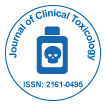
Journal of Clinical Toxicology
Open Access
ISSN: 2161-0495

ISSN: 2161-0495
Short Communication - (2025)Volume 15, Issue 1
Pediatric toxicology is a vital subfield of medicine focused on the prevention, diagnosis, and management of toxic exposures in children. Children are especially vulnerable to toxic substances due to their unique physiological characteristics and developmental behaviors. Accidental ingestions of medications, householdchemicals, and environmental toxins remain common among infants and young children, whereas adolescents are increasingly affected by intentional exposures. This commentary highlights the challenges, trends, and strategies in pediatric toxicology, including the role of poison control centers, emerging toxic threats, and the need for improved prevention and education efforts. Emphasis is also placed on theimportance of integrating toxicology training in medical education and strengthening public health policies to reduce the burden of poisoning in pediatric populations.
Pediatric toxicology; Poisoning; Child safety; Poison control; Toxic exposure; Accidentalingestion; Toxicology education; Public health.
Pediatric toxicology deals with the clinical and preventive aspects of toxic exposures in children, a population uniquely susceptible to poisoning due to their developmental stage, behavioral patterns, and physiological differences. As toxic exposures remain a major cause of emergency visits and hospitalizations among children globally, this field plays a crucial role in both acute clinical management and long-term public health planning. Understanding and addressing pediatric toxicological risks is essential for reducing preventable harm and safeguarding child health.
Toxicological Vulnerabilities in Children
Children are physiologically and developmentally distinct from adults, which significantly influences their responses to toxic substances. Immature liver enzyme systems can alter drug metabolism, while a lower body mass and higher surface area-to-volume ratio increase their susceptibility to the harmful effects of toxins. Additionally, developmental behaviors such as crawling, mouthing objects, and exploratory ingestion—further elevate the risk of accidental exposures during early childhood.
Common Sources of Pediatric Toxic Exposure
In children under five years of age, most toxic exposures are accidental and occur within the home environment. Frequently involved substances include household medications (notably iron supplements, analgesics, and antihypertensives), cleaning agents, and personal care products. In contrast, adolescents are more likely to experience intentional toxic exposures, including the misuse of recreational drugs or suicide attempts. These age-specific patterns demand tailored prevention and intervention strategies.
Clinical Presentation and Diagnostic Challenges
The clinical manifestations of toxic exposures in children are often nonspecific and can mimic a range of common pediatric illnesses. Symptoms such as vomiting, altered mental status, seizures, and respiratory distress may obscure the underlying toxicological cause. While specific antidotes can be critical in certain cases, supportive care remains the primary approach in most pediatric poisonings.
Role of Poison Control Centers (PCCs)
Poison Control Centers play a pivotal role in the management of pediatric poisoning cases. They offer 24/7 access to evidence-based clinical guidance for healthcare professionals and caregivers. By assisting in early triage and treatment decisions, PCCs help reduce unnecessary hospital visits and optimize resource utilization. Furthermore, the data they collect contribute to national surveillance efforts and inform public health policy and education.
Prevention and Public Health Strategies
Preventing pediatric toxic exposures requires comprehensive, multi-tiered interventions. Key strategies include educating caregivers about safe storage and handling of hazardous substances, promoting the use of child-resistant packaging, and enforcing regulations on the marketing and accessibility of potentially toxic products. Community-based awareness programs and school curricula can further reduce risk. Addressing socioeconomic disparities that increase exposure risks among vulnerable populations is also essential for achieving equitable child health outcomes.
Emerging Toxicological Threats
The landscape of pediatric toxicology is rapidly evolving with the emergence of new hazards. Increased exposure to cannabis edibles, synthetic drugs, vaping products, and adult prescription medications has been reported among children and adolescents. These substances are often attractively packaged and insufficiently regulated, posing a growing threat that necessitates updated safety guidelines, regulatory measures, and public awareness efforts.
Training and Research Needs
Integrating pediatric toxicology into medical and nursing education is crucial to ensuring clinicians are equipped to manage poisoning emergencies effectively. Ongoing research is needed to explore pediatric-specific pharmacokinetics, develop novel antidotes, and understand the long-term health implications of early-life toxic exposures. Enhanced clinical training and scientific inquiry will support the development of more effective treatment protocols and prevention policies.
Pediatric toxicology is a crucial and dynamic field that bridges the realms of clinical medicine, toxicology, and public health. Children are uniquely vulnerable to toxic exposures due to their physiological, developmental, and behavioral characteristics, making prompt recognition and management of poisoning cases a public health priority. To effectively reduce morbidity and mortality, a multifaceted approach is required—one that includes caregiver education, secure storage of hazardous substances, and widespread public awareness. Moreover, enhancing the capabilities of poison control centers, updating clinical guidelines based on emerging trends, and integrating toxicology education into medical and nursing curricula are critical. Continued research, data surveillance, and intersectoral collaboration will ensure adaptive, evidence-based responses to evolving toxicological threats and help build a safer environment for children worldwide.
[Crossref]
[Crossref]
Citation: Vries OD (2025). Pediatric Toxicology: A Critical Frontier in Child Health and Safety. J Clin Toxicol. 15:584.
Received: 03-Jan-2025, Manuscript No. JCT-25-37434; Editor assigned: 06-Jan-2025, Pre QC No. JCT-25-37434 (PQ); Reviewed: 20-Jan-2025, QC No. JCT-25-37434; Revised: 27-Jan-2025, Manuscript No. JCT-25-37434 (R); Published: 06-Feb-2025 , DOI: 10.35841/0976-4860.25.15.584
Copyright: © 2025 Vries OD. This is an open-access article distributed under the terms of the Creative Commons Attribution License, which permits unrestricted use, distribution, and reproduction in any medium, provided the original author and source are credited.